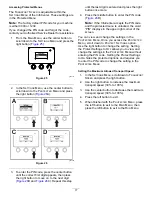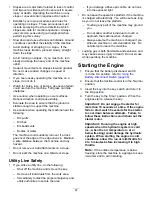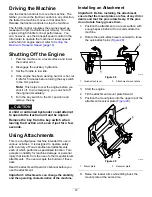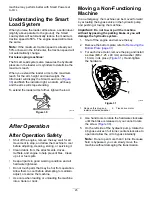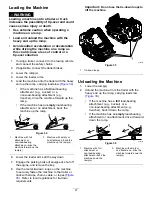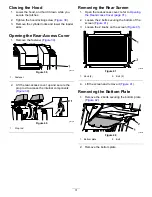
•
Slopes are a major factor related to loss of control
and tip-over accidents, which can result in severe
injury or death. Operating the machine on any
slope or uneven terrain requires extra caution.
•
Establish your own procedures and rules for
operating on slopes. These procedures must
include surveying the site to determine which
slopes are safe for machine operation. Always
use common sense and good judgment when
performing this survey.
•
Slow down and use extra care on hillsides. Ground
conditions can affect the stability of the machine.
•
Avoid starting or stopping on a slope. If the
machine loses traction, proceed slowly, straight
down the slope.
•
Avoid turning on slopes. If you must turn, turn
slowly and keep the heavy end of the machine
uphill.
•
Keep all movements on slopes slow and gradual.
Do not make sudden changes in speed or
direction.
•
If you feel uneasy operating the machine on a
slope, do not do it.
•
Watch for holes, ruts, or bumps, as uneven terrain
could overturn the machine. Tall grass can hide
obstacles.
•
Use caution when operating on wet surfaces.
Reduced traction could cause sliding.
•
Evaluate the area to ensure that the ground is
stable enough to support the machine.
•
Use caution when operating the machine near the
following:
– Drop-offs
– Ditches
– Embankments
– Bodies of water
The machine could suddenly roll over if a track
goes over the edge or the edge caves in. Maintain
a safe distance between the machine and any
hazard.
•
Do not remove or add attachments on a slope.
•
Do not park the machine on a hillside or slope.
Utility Line Safety
•
If you strike a utility line, do the following:
– Shut off the machine and remove the key.
– Remove all individuals from the work area.
– Immediately contact the proper emergency and
utility authorities to secure the area.
– If you damage a fiber-optic cable, do not look
into the exposed light.
•
Do not leave the operator’s platform if the machine
is charged with electricity. You will be safe as long
as you do not leave the platform.
– Touching any part of the machine may ground
you.
– Do not allow another individual to touch or
approach the machine when charged.
– Always assume the machine is charged if you
strike an electrical or communication line. Do
not attempt to leave the machine.
•
Leaking gas is both flammable and explosive and
may cause serious injury or death. Do not smoke
while operating the machine.
Starting the Engine
1.
Ensure that the battery-disconnect switch
is in the O
N
position; refer to
Battery-Disconnect Switch (page 39)
.
2.
Ensure that the traction-control is in the N
EUTRAL
position.
3.
Insert the key into the key switch and turn it to
the O
N
position.
4.
Turn the key to the S
TART
position. When the
engines starts, release the key.
Important:
Do not engage the starter for
more than 10 seconds at a time. If the engine
fails to start, wait 30 seconds for the starter
to cool down between attempts. Failure to
follow these instructions could burn out the
starter motor.
Important:
Running the engine at high
speeds when the hydraulic system is cold
(i.e., when the air temperature is at or
below freezing) could damage the hydraulic
system. When starting the engine in cold
conditions, allow it to run at mid-throttle for
2 to 5 minutes before increasing it to high
throttle.
Note:
If the outdoor temperature is below
freezing, store the machine in a garage to keep
it warmer and to aid in starting.
22










